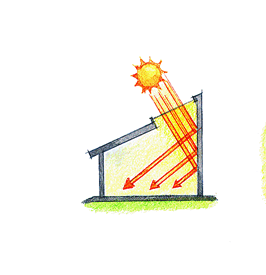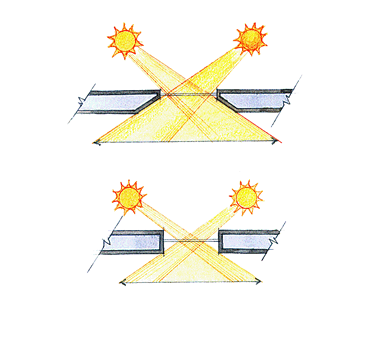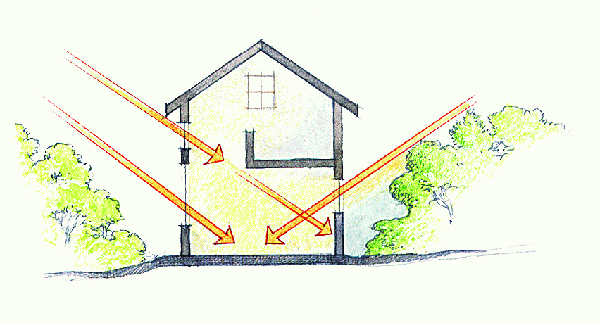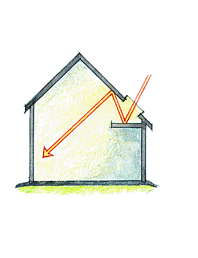ABOUT PASSIVE HEATING AND DAYLIGHTING
Start your design with a compass.
Think about how the sun moves through the day and through the year when you start designing your floor plan. Selective siting, shading, and construction strategies can save money on lighting and heating bills. Also, a house with plenty of natural light is more pleasant to be in.
Design floor plans to use sun all day long. Think of a house as four distinct quadrants, each with its own potential for daylight and free heat, depending on the sun’s position during the day.
Morning sun is dominant in east-facing rooms. Locating the dining room or breakfast nook and the kitchen on the east wall makes the most of light potential early in the day. It’s also a good place for a dense floor that can soak up some solar heat for the day. Bedrooms with east-facing windows will be great for early risers but terrible for people who like to sleep in.
Sunlight is strongest on the south wall. This is the right quadrant for the living room and other spaces that will be used throughout the day. For heat gain, rooms with south-facing windows are another good choice for dense materials like stone, brick, or concrete.
Early evening light from the west is at a low angle. Because the sun is so low in the sky, west-facing windows get direct sunlight blazing through them. This makes west-facing rooms a bad choice for TV rooms because strong light makes screens harder to see.
In cold areas, this is the last chance of the day to soak up some sun; in hot areas, it’s the most important window to shade with trees. A west bedroom is good for people who like to sleep in because the room is very dark in the morning.
North rooms have the least natural light. They also have the greatest potential for heat loss through windows. This is a good place for bathrooms, utility rooms, entries, and other rooms where natural light isn’t as important. That said, painters and artisans might appreciate generous north-facing windows because of the quality of the light.
Of course, cooling a house can be expensive, too.
The sun’s orientation is just as important for houses built in the Sunbelt, where controlling heat gain in the summer lowers cooling costs and creates a more comfortable indoor environment.
You can lessen temperature swings in houses in all climates by using dense materials in key areas. Siting a house thoughtfully can make these areas inviting rooms.
MORE ABOUT DAYLIGHTING
Find other ways to let in light.
Not every room in a house can have generously sized windows that admit natural light. Rooms at the interior core of a house as well as those facing north sometimes get shortchanged.
Open floor plans allow light from skylights and windows to penetrate deep into a house. Skylights over stairways, for example, can bring light into the center of a house.
Skylights are a simple way of introducing light to rooms right below roof level. Both fixed and operable skylights are available.
Angled (splayed) walls broadcast the most light, and placing skylights near a wall creates a pleasant light-washing effect on the wall surface.
Skylights have a negative trade-off, however: a high potential for energy loss because even the best have a higher U-factor (lower R-value) than well-insulated walls and ceilings.
Skylights also can produce unexpected glare and uncomfortably warm indoor temperatures unless they have shades. With this in mind, in most climates it is wise to limit skylights to north roof slopes. At least consider the path of the sun throughout the day when picking skylight locations.
Tubular skylights incorporate a plastic, roof-mounted dome, a highly reflective rigid or flexible tube, and a light diffuser mounted in the ceiling. As long as there is good attic access, a tubular skylight can be easily installed in most existing homes. Tubular skylights are expensive replacements for lightbulbs, but they offer natural light over artificial light, and you won’t waste energy if you leave the “light” on. They’re a good option for dark interior spaces like bathrooms.
Ridge skylights, dormers, and clerestories can add natural light to interior spaces where windows are not an option or where more natural light is desired. A clerestory—a band of windows installed between the ridge of an upper shed roof and the ridge of a lower shed roof—can throw light far into a room. Operable windows improve air circulation.
Light shelves, located directly below skylights or clerestories, bounce light back toward the ceiling and provide good indirect lighting to a large room. Light shelves can also block glare from overhead sun when skylight placement options are limited.
Consider interior colors, too. Light colors reflect light more easily than darker shades. Interiors painted in light colors will feel larger and brighter, and make it easier to use daylight as task lighting.
A FEW DAYLIGHTING STRATEGIES TO CONSIDER:
Place a house on the site so that light is managed easily.
Let light in by angling the house properly, using trees or awnings to shade the windows during the heat of the day, and sizing the overhangs to admit winter light while blocking the hot summer sun.
To balance light, shape the house so that light can enter every room from at least two sides.
Four-square styles are a traditional way of evenly admitting light. Adding a courtyard, atrium, or skylight can illuminate an interior from above. Also, an H- or C-shaped house offers many rooms that can let light in from two sides. There are trade-offs to consider, however; H- and C-shaped houses are less compact, and therefore less energy efficient, than compact rectangular houses.
Where light from a second side isn’t possible, provide light from above.
Skylights and clerestory windows are two ways to sneak light in from up high. There are many ways to bounce that light around to dim corners such as light shelves and flared skylight shafts. Remember, though, that skylights are a weak link in a home’s thermal envelope, and should therefore be used sparingly.
Shape and locate each opening to suit both the climate and the room.
Does the space need bright task lighting or warm ambient light? Are the windows more important for lighting or solar heat gain? Would large windows be a liability in an otherwise well-insulated space? Such questions that require careful evaluation of the site conditions and the home’s needs.
Excerpted from Fine Homebuilding magazine
Bird’s-Eye View

Image Credits: Martha Garstang Hill/Fine Homebuilding #172
Siting can keep a house warm and cool
How a house is oriented to the sun has a dramatic impact on heating and cooling costs — the largest energy load in most homes.
As promising as photovoltaic (PV) and solar hot water collectors are for reducing our reliance on fossil fuels, passive solar design alone can lower heating costs tremendously. Much of the reduction is available without spending an extra dime.
Key Materials

Image Credits: Joseph Kugielsky / Fine Homebuilding 166
Use concrete wisely and choose windows well
Specify different types of window glazing for different sides of the house. While west-facing windows require low-solar-gain glazing, south-facing windows (in all but the hottest climates) require high-solar-gain glazing. Although high-solar-gain low-e glazing is available from major glass manufacturers, it is often unavailable from U.S. window manufacturers. Canadian window manufacturers are much more likely to stock high-solar-gain glazing.
Dense materials like stone and concrete soak up the sun’s energy during the day and release it at night. High thermal mass helps smooth out swings in temperature even without the benefit of mechanical heating and cooling. Rooms that have higher thermal mass can afford larger window areas because the heat generated by the sun has somewhere to go. Rooms with low thermal mass and large windows can overheat and suffer wider temperature fluctuations.
Design Notes
##Designing for daylighting has its own unique issues
Pay attention to critical areas: kitchen, office, reading area. In many households, the occupants are gone for a large part of daylight hours. This, combined with the fact that code requires regularly inhabited spaces in the home to have windows, may mean that “design as usual” will provide adequate results for daylighting purposes. Areas that may benefit from more attention are those where critical visual tasks take place — kitchen workspaces, offices, hobby and reading areas. Other daylighting opportunities not to overlook include utility rooms and walk-in closets. In these spaces, quality daylighting can significantly reduce the need for artificial lighting. “Solar tubes” (narrow, tubular skylights) may be particularly useful in these types of locations.
Builder Tips
Flashing a curbed skylight
A skylight is a great way to bring light deep into a house but can be a leaky mess if it’s not installed well. Whether your flashing comes as a kit or you make it yourself, follow these basic steps to get it to work right.
The Code
More windows mean more insulation
Lots of passive solar heat can mean that you have to be better than code. Chapter 11 of the IRC sets the baseline for energy efficiency in building envelopes — but if you’re considering passive solar heating, you’ll probably have to do better than code. Directly using the sun’s heat usually means plenty of south windows. If glass covers more than 15% of your exterior walls, you’ll need to meet the stricter insulation requirements prescribed by the IECC.
Even though the IECC sets the bar a bit higher, a passive solar home has some unique needs that might encourage you to up your R-values by as much as 40% or 50%.
Thermal mass can help, if it’s insulated
Many passive homes rely on thermal mass of masonry floors or walls to hold some of their heat into the night. If these large heat sinks are only insulated to the code minimum, they may actually be fighting your passive gain instead of helping it.
Windows don’t work when the sun isn’t shining
The IECC tries to compensate for all that extra glass with higher R-values in the rest of the building envelope. But even if you superinsulate your walls and ceilings, the best windows will still be the weak link when it comes to heat loss. Movable insulation is not often thought of as a building envelope component, but maybe it should be. Simple accordion shades or insulated curtains will require routine manual operation, while automated window insulation systems can be triggered by light or temperature sensors — providing convenience along with a potential maintenance headache.
OTHER CONSIDERATIONS
can affect how well your site design works for your house.
Drainage patterns of a site can affect landscape choices and foundation durability.
MAKE IT GREENER
Shade walls with roof overhangs
Direct sun eats up siding faster than anything else. Even small roof overhangs provide shelter for walls, and deep overhangs can shelter the whole wall.
Collect sun, block sun
In hot climates, use deciduous trees to shade summer heat while letting some winter heat in. Roof overhangs can do the same job if designed with the sun’s seasonal path in mind.
TRADE-OFFS
Windows mean free heat and light, but they also amount to a big hole in the wall that must be leak-free. Problem is, many windows aren’t leak-free.
Skylights can bring daylight into dark interior rooms, but like windows, they too can amount to leak-prone holes — in the roof! They also let in unwanted heat in the summer.
Window placement should work well inside and look good outside. The balance between what looks good inside and what looks good outside matters because people tend not to take care of unattractive houses.
Sunlight can affect a thermostat, a good thing to keep in mind when deciding where to install them. A thermostat will do a better job of regulating indoor temperatures when it is kept out of direct sunlight and placed in a central location.
GREEN POINTS
LEED for Homes 1 point under ID 1.5 (Innovation & Design Process) for meeting passive solar design criteria.
NGBS Under Ch. 7 — Energy Efficiency: 4 points for meeting passive solar design requirements (704.3.1.4); 2 points for skylights (704.2.4).























9 Comments
Designer Radiators
This post gets an instant bookmark! It reminds me of my favorite home design book from the 80s, It was a Time Life book on sustainable living and how I miss it. Such simple yet effective ideas for heating and lighting which can be utilized (and should be utilized) with the slightest bit of effort and forethought. Can you imagine the combined energy savings if all, or even just 50% of new homes followed just a few of these tips? It's shocking that this sort of basic building common sense is left out of most new home designs!
Thanks for posting this excellent article!
Steve
Passive heating
I am a registered architect and have designed over 60 passive solar houses primarily in the middle Atlantic and Northeast. In my experience two of the biggest myths of passive solar design are repeated in this article. In locations with colder climates: 1. Never plant or locate a house with deciduous trees on the south side to provide summer shading- even with leaves down they still cause a substantial reduction in heat gain; also, if they ever get big enough to actually do any shading they will affect any active or PV collectors that might be on the roof. 2. Never construct significant roof overhangs on the south side to minimize summer heat gain- this isn't really a concern since the high angle of the sun causes mostly reflection rather than heat gain and, most importantly, the overhangs significantly reduce desireable spring and fall heat gain on cool days.
South roof overhangs
Pete,
I agree with you completely on deciduous trees — in fact I corrected the text of the article to reflect your point. However, I disagree with you concerning south overhangs. Can you point to a study with field data to support your contention?
Passive heating
Martin, My comments are based primarily on my own experience and observations, having lived in seven passively heated houses and having designed many more. The altitude of the sun during the summer months is high enough to minimize heat gain. It is a non-issue in this climate anyway unless air conditioning is in use, since any minor heat gains are mitigated by the thermal mass and simple window ventilation. On cool spring and fall days you certainly do want any shading- I actually had a client remove south elevation overhangs from a house I had designed many years ago for this reason.
While I have my myth buster hat on-here are two more: First a passive house can be oriented as much as 25 degrees off true south with negligible impact on performance. Recently published tables show an approximate 10-15% loss, but I currently have two identical passively heated buildings-one a home and the other a studio, built side by side, but with one facing due south and the other
facing west of south by 25 degrees. Both perform almost identically as far as internal space and thermal storage temperatures at the end of a sunny day. The two buildings seldom vary by more than one or two degrees, with the westerly facing building performing slightly better in the spring and fall and the other performing slightly better in the winter. My second comment has to do with the statement in the above article that a roof overhang will protect the siding. This seems a bit of a stretch since the overhang will shade only a small fraction of the siding on the house, and where it does shade is where there should be glass for solar gain.
My Jan 4 post
Obviously I have a typo in the seventh line; it should read "...certainly you do not want..." Sorry, Pete
Pete Powell's blog
Pete Powell has contributed a blog in which he develops his ideas on passive solar design.
Read all about it: "A Contrarian View of Passive Solar Design."
The link moved: https://www.greenbuildingadvisor.com/article/a-contrarian-view-of-passive-solar-design
Thanks, John. I have corrected the link.
Dear Sir, i would like to request the copyright permission for this photo to reproduce and used in my academic article. Can i get copyright owner email and contact. Thanks.
Log in or create an account to post a comment.
Sign up Log in